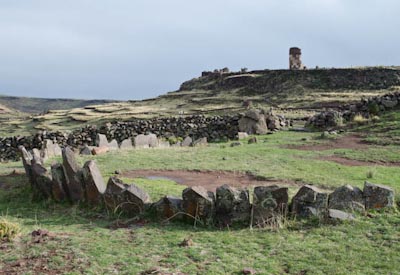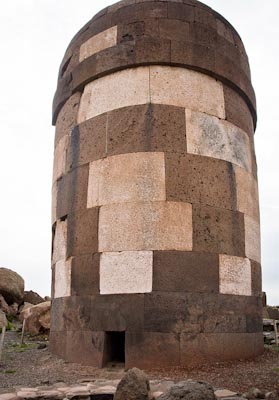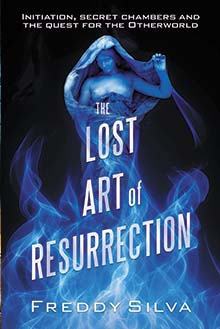Silustani’s position on a flat-top hill of iron-bearing andesite, packed with magnetite, and surrounded by water appears to have been deliberately chosen to assist the process. These elements by themselves generate a geomagnetic field, and when combined with a variation of adjacent soil and its accompanying fault line, produce what is known as a conductivity discontinuity. Most of the world’s sacred places, particularly those associated with rituals involving altered states, lie precisely at such junctions — Petroglyph Mesa in Albuquerque, New Mexico; Carnac in France; and Loughcrew in Ireland to name a few. Simply put, the harnessing of GMF inside a man-made structure amplifies the forces that facilitate a hallucinatory state. A dead person has no use for this, but a person lying in a state of meditation inside an artificially-constructed womb, does.
An hour’s drive south lies another group of chullpas, at Cutimbo, again atop an imposing mesa, this time made chiefly of limestone; it too was once an island in the west, and its choice was deliberate. Water percolating through limestone creates adsorption, a natural phenomenon that generates a low-lying electrical field. In ancient times the hill would have been charged, so to speak, very useful for activating the one essential component that induces shamanic journeying, the pineal gland. Lying inside the light-deprived environment of a chullpa offers a further advantage in that it promotes the chemicals melatonin and pinolene, which allow for the creation of the hallucinogen DMT. Precedents for this identical spiritual technology include the dense concentrations of sacred sites in Yucatan, Wiltshire (England), The Burren (Ireland), and the ritual chambers of the Tewa in New Mexico.
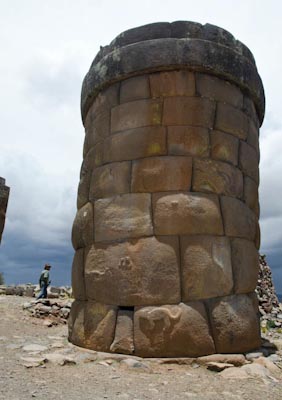
Chullpa at Cutimbo. Note the relief above the door of the initiate with his ‘bride’; the low entrance is flanked by the two dogs of the Aymara Otherworld myth who guide the initiate through the dark, much like Anubis.
The towers at Cutimbo differ inasmuch as they are fitted to the same precision yet are carved like billowing pillows. If you happen to be at the main chullpa around midday, with the Sun at its zenith, something wondrous occurs: the light cast upon the façade reveals relief carvings above the doorway of what appear to be a male and a female figure. One of the recurring themes of living resurrection ceremonies, particularly among surviving accounts from Greece, is the description of the initiate who crosses the threshold into the Otherworld to couple with the celestial bride, hence why rooms used for raising the dead were called bridal chambers. This sacred marriage is immortalized in the myth of Osiris, the god-man who is reassembled and resurrected by his bride Isis following a ritual death. The story would be refashioned for a different audience during the Dark Ages in Europe as King Arthur and his perilous journey to an island in the West to find a Grail.
Either side of the entrance there also come into view the reliefs of two large dogs, which at first seems an unusual choice of creature to etch on a ritual chamber. But not to the Aymara, whose religious system taught that a soul experiencing resurrection undergoes an ordeal while finding its way to the Otherworld. The Andean account of this afterlife journey uses the symbol of a bridge across a raging river. As the soul crosses this river into darkness it is assisted by black guide dogs capable of seeing in the dark. It is an identical motif used in the Greek and Egyptian resurrection rituals, namely the Hounds of Hades, and Anubis and Upauat.
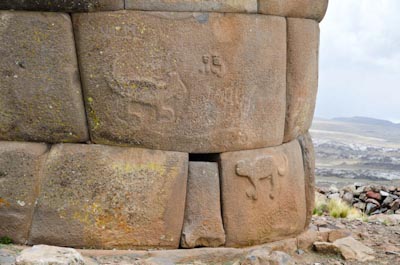
Close-up of the carved reliefs of two dogs and the initiate coupled with his divine bride. Such chambers are known in other parts of the world as bridal chambers.
Chullpas are referred to by Andean people as uta amaya, ‘houses of the soul’. Notice ‘of the soul’ and not ‘for the soul’, a seemingly innocuous difference yet a major one: it defines the chambers not as final repositories but places of facilitation. The only one way in is through a tiny rectangular hole, forcing even the smallest of people to scramble on all fours as though forcing the ego to be humbled — one of the pre-requisites in ritual initiation.
The entrances still have their stone plugs. Which made me wonder: if these were graves, why add an entrance, and a bloody inconvenient one at that? One only has to be reminded of the stone that rolled away from the sepulchre holding Jesus during his own living resurrection ritual, for this stone plug was meant to seal the candidate inside, only to be removed by officiating priests at sunrise, when the light of the rising Equinox sun casts a beam directly into the chullpa.
Even after acclimating to the dark it is hard to make out the shape of the interior. When one of the towers partially collapsed it thankfully revealed how the core masonry is fitted in the shape of a beehive, and in doing so offers another indication these places were designed with ritual resurrection in mind.
The use of the beehive chamber in ritual initiation follows a world tradition of association with the bee. Since the bee and the honeycomb effortlessly characterize the manifestation of divine harmony in nature, bees were considered a link between life and afterlife. Regenerative nature gods such as Vishnu, Pan and Aphrodite are depicted as honey bees on a flower. More tellingly, priestesses honouring the cults of fertility, such as those of Ceres and Demeter, were nicknamed bees, as were the women who assisted candidates undergoing initiation in secret chambers. The honeycomb was also linked with personal insight and divine wisdom, and the concept is immortalized in the Bible: “Jonathan...put forth the end of the rod that was in his hand, and dipped it in a honeycomb, and put his hand to his mouth; and his eyes were enlightened.”
Such characteristics shaped the architectural blueprint of ritual chambers around the world, from the beehive domes of the Cuchama of southern California, to those of the Celts in Britain, specifically at Newgrange, Achnacree, and the stone huts on the summit of that classic island in the west Skellig Michael. The beehive was reintroduced two-dimensionally throughout Europe in the shape of the Gothic arch by a group who also conducted raising the dead rituals in bridal chambers, the Knights Templar.
The ancient architects of the chullpas may have left no record of their practices except what remains etched in local tradition, yet by comparing their remaining artefacts to similar cultural practices elsewhere we begin to understand the function these structures originally served. As the Egyptians themselves knew so well, in this case, the funerary connection was not the deceased, but a living candidate who, via a voluntary near-death experience, sought an experience of the Otherworld.
The chullpas of Silustani and Cutimbo are by no means the only sites used by the ancient Andeans to reach the Otherworld. Next we’ll examine some other famous places.
continue to part II
Return to Articles
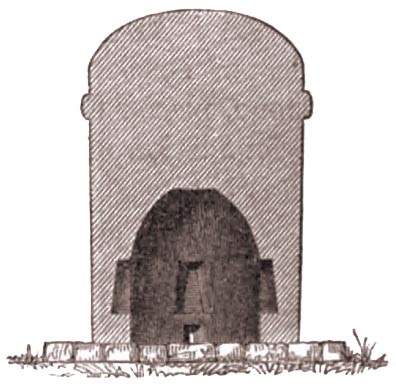
Cutaway drawing showing the beehive construction of a chullpa.
